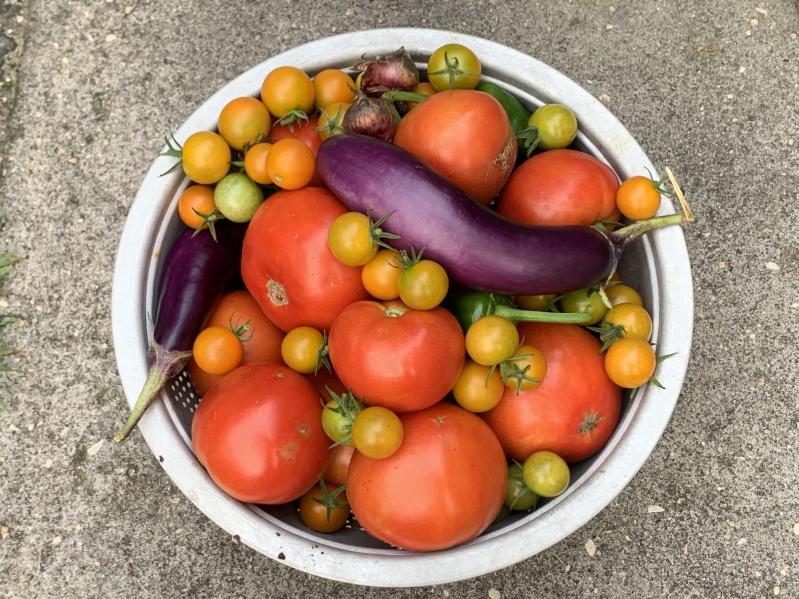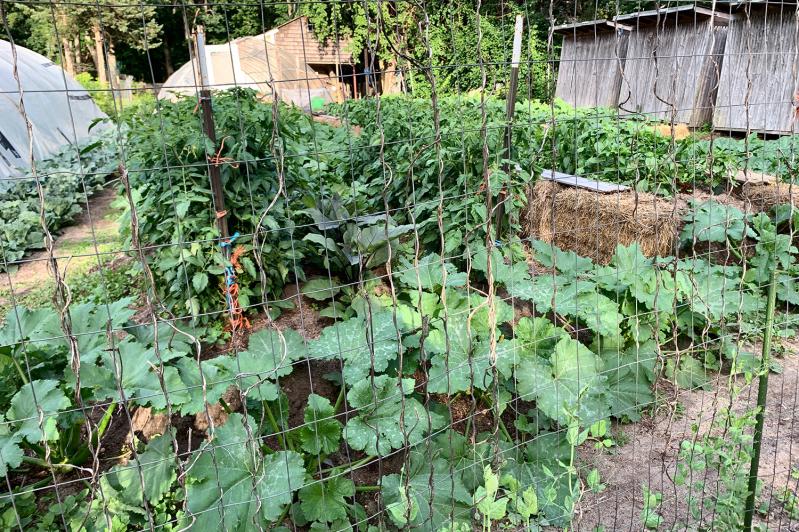You’ve seen local farm stands and East End farmers markets teeming with luscious produce all summer. What could be better, even fresher, than that?
Growing your own.
Maybe you find the thought overwhelming, or you’ve tried and failed. May we suggest digging in with our advice — alongwith the important directions found on the back of seed packets — and you’ll be off to a solid start. And between tasks, we urge you to sit in your garden and drink cool tea, listening to the songbirds urging you on.
What Grows Well on the East End
Farmers know what will yield lots of produce in this soil: wine grapes, potatoes, corn, cauliflower, tomatoes, apples, peaches, berries, beans, peppers, squash, cucumbers, greens, carrots.
Are these also the crops that grow best in the home garden? Yes and no.
In our climate, which is categorized as humid subtropical, it’s nearly impossible to grow aesthetically pleasing fruit without the use of pesticides.
The good news: You can grow a ton of tomatoes, peppers, cucumbers, greens, squashes, potatoes, beans, and herbs in your home garden with relatively little effort.
Think of fruit trees and fruit plants in your garden as ornamental. If they produce handfuls of sweet goodness, that’s a bonus. The exception is raspberries. Once established, these babies will spread with abandon.
Corn requires that you plant at least a couple rows of the stuff so it can land pollen on nearby silks for fertilization. Its tough roots dig in and take a lot of nutrients out of the soil. You may or may not get a few good ears; you will definitely get a worm at the end of every ear. So corn in the home garden should also be treated as an ornamental.
Cauliflower and its big, white head of a flower is labor-intensive and tricky.
The Ease of Raised Beds
A “raised bed” is simply that — an elevated area that has been piled evenly with soil for planting. It may be enclosed in a wood or metal frame. Bringing the bed level up means you don’t have to lean down so far or crouch to plant, weed, and harvest.
Never walk on a raised bed’s soil. Keep it uncompacted; it will have superior aeration and water flow, making it easier to plant, water, and to pull roots from.
Grow vining plants, such as tomatoes, cucumbers, beans, and squashes, on trellises. This way they won’t fill up a whole bed. Or, look for smaller “bush” varieties that have finite or “terminate” growth.
Some crops can be planted more closely together, as the looser soil in a raised bed readily allows roots to grow straight downward. Be sure to water: give all your seeds and plants a big drink when you put them in the ground to start them off.
Plan to pick pickling cucumbers and zucchini as soon as you see they are of size — they can grow as much as five inches in one day!
Thoughts on Container Gardening
Potting up old relics like teapots, crocks, lobster pots, and buckets can add color and interest to the garden. Such a collection could even be your garden. Lined up along a driveway or stoop, potted kitchenalia says “welcome, have some fresh food.”
Watering and drainage are key. Container gardens must be watered at least once a day in the summertime. But our periodic heavy rains mean that the vessels must have drainage holes.
Or, in the case of crocks, you might include a deep bottom layer of air pockets by using Styrofoam peanuts or an old, overturned colander.
Many herbs, such as chives, borage, and rosemary, embrace the contained life. Longer-rooted vegetables, including carrots and beets, do not.
Look for smaller varieties of the vegetables you want to grow, like fairy tale eggplant and currant tomatoes, so they can be happy and productive in their limited growing environment.
Potatoes need more than a foot of soil to thrive. Give small potatoes a big container such as an old zinc tub to grow in and you’ll enjoy an easy harvest. When the plant dies down at the end of the season, just turn that container over onto a tarp and your potatoes will appear.
The Value of Herbs
Ask any chef or home cook what her secret is, and she might just smile, shrug her shoulders, and go back to chopping a pile of fresh herbs.
While you can get by serving store-bought potatoes prepared as French fries, or last week’s beets as borscht, there simply is no substitute for garden-fresh herbs — and lots of them.
Luckily, many herbs, including mint, dill, and rosemary, grow like weeds once they are well established. Treat herbs as Persian cuisine does — like a big ol’ vegetable. Be bold. Make your potato salad green with dill and parsley, your honeyed carrots awash with chopped chives. You already know exactly what to do with basil during tomato season and “pesto season.”
Why Grow Edible Flowers?
“The birds and the bees” is not just an uncomfortable conversation your mom tried to have with you when you were in middle school. These creatures, and the many friendly insects in your garden, are key pollinators. You need these little guys to fertilize your crops, or . . . no crops.
How do you attract pollinators?
Offer them a variety of bright flowers so these helpers are hanging around when your vegetable plants blossom.
You can also enjoy eating a salad bursting with the colorful petals of these flowers: cornflower, dandelion, daylily, honeysuckle, marigold, nasturtium, pansy, rose, violet. Herb flowers are edible, and they are packed with flavor; taste them before you load up a salad, or use them as a garnish.
Preserving the Bounty
There’s no such thing as “too many tomatoes.” All the fruits of your labor are a blessing deserving of celebration.
That said, if you’re diligent and lucky, you may feel overwhelmed by the bounty at times.
You can quick-pickle just about anything in the refrigerator. Just blanch your chosen vegetables and submerge them in a brine for a couple of days. Can you reuse the brine leftover from a commercial jar of pickles? Heck yes.
While old-timers form a human chain and set a big pot of water to boil in summer’s heat to home-can, or “put up,” many people swear by freezing. Be sure to look up whether the given produce freezes well, and if it needs to be blanched before being frozen. Remember that water expands when it turns to ice, and leave your bagged veggies a little room to grow.
A jar or frozen bag of crushed tomatoes contains a multitude of possibilities. You might find it convenient to prepare big batches of pasta sauce or salsa, thereby using up bumper crops of peppers, onions, garlic, and herbs along with your tomatoes.
Look up recipes to see if freezing the given food product might require somewhat different proportions of water, spices, or salt than a standard recipe.
No garden is perfect. Start small and make lots of mistakes, so you learn what works for you.
—
Top Crops: Tried-and-True Vegetable Varieties
These are some types, and specific varieties, of vegetables to look for in seed catalogs and at garden centers that local farmers and gardeners have found to grow particularly well in our soil. The beginner gardener should plan to buy tomatoes and peppers as young plants. Cucumbers, squashes, and potatoes may be grown from seed.
Tomatoes
Large: Big Beef, Jet Star, Park's Whopper
Medium: Early Girl, Lemon Boy
Small: Matt's Wild Cherry, Sungold
Paste: Amish Paste, San Marzano
Peppers
Sweet: King Arthur, Lady Bell, Lunchbox, New Ace
Hot: Carolina Cayenne, Green Cayenne, Helios (orange habanero), Jalapeno, Shishito
Cucumbers
Slicers: Diva, Lagos, Marketmore, Striped Armenian, Suyo Long, Tasty Jade
Picklers: Boothby’s Blonde, Cross Country
Squash
Summer: Dark Green Zucchini, Delicata, Dunja, Gold Rush, Green Machine, Patty Pan, Raven, Yellow Zucchini, Zephyr
Winter: Blue Hubbard, Honeynut, Sweet Dumpling, Waltham Butternut
Potatoes
Red Gold, Rose Gold, Yukon Gold (though not a big producer)
Fingerling: Russian Banana
—
Stacy Dermont is a home gardener and co-author, with Hillary Davis, of the best-selling regional cookbook and wine-pairing guide “The Hamptons Kitchen.” It contains her famous recipe for compost.


